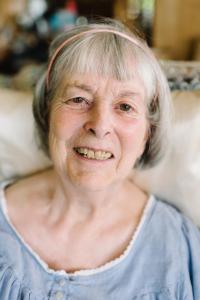Geneneiva "Deedie" Pearson

West Side Stories
These oral histories chart the personal stories of individuals with a longtime connection to the west side of Kodiak Island, defined for the scope of this project as the area buffeted by the Shelikof Strait that stretches from Kupreanof Strait south to the village of Karluk. The project endeavored to create historical primary source material for a region that lacks substantive documentation and engage west side individuals in the creation of that material.
Geneneiva (Deedie) Pearson was interviewed by Anjuli Grantham on June 12, 18, and 26, 2015, in Kodiak, Alaska as part of the Kodiak Historical Society’s West Side Stories project. Deedie Pearson came to Kodiak in 1941 at the age of seven, when her father’s job with the Territory of Alaska brought the family to the area. (Her father was Alfred Owen, who represented Uganik Bay in the 1st Alaska State Legislature, 1959-60, as well as other political offices before and after statehood). She describes Kodiak as full of servicemen and bustling with military activity in the time just before America entered World War II. Local stores had only just started accepting money, operating before on “PAY” credit: pay after fishing. She describes growing up and living in places such as Marmot Island and Mush Bay, and her family’s efforts at fox trapping, fishing, farming, and eventually starting the Uganik Trading Company cannery. She details the seining gear used at the time (her father bought a boat in 1945 and worked as an independent fisher though most fishermen at the time worked a percentage on the cannery boats), setnetting and its pioneers in the 1920s, beach seining, mining operations, and the different canneries in the area. She also describes the food they grew, how they canned and preserved food and salted fish. She touches on the evolution of gear and boats, the role of Fish and Game in rebuilding the fisheries after statehood, the 1964 earthquake and tsunami, the fishermen strikes, the impact of the Exxon Valdez oil spill, and the role that alcohol played in a number of local shootings. She tells many colorful stories of the area’s well-known residents and recounts how the local ways of life teach residents the value of cooperating and helping each other in times of need.
Please Note: The oral histories in this collection are protected by copyright and have been created for educational, research and personal use as described by the Fair Use Doctrine in the U.S. Copyright law. Please reach out Voices@noaa.gov to let us know how these interviews are being used in your research, project, exhibit, etc. The Voices staff can help provide other useful resources related to your inquiry.
The NOAA mission is to understand and predict changes in climate, weather, oceans, and coasts, to share that knowledge and information with others, and to conserve and manage coastal and marine ecosystems and resources. The Voices Oral History Archives offers public access to a wide range of accounts, including historical materials that are products of their particular times, and may contain offensive language or negative stereotypes.
Voices Oral History Archives does not verify the accuracy of materials submitted to us. The opinions expressed in the interviews are those of the interviewee only. The interviews here have been made available to the public only after the interviewer has confirmed that they have obtained consent.
